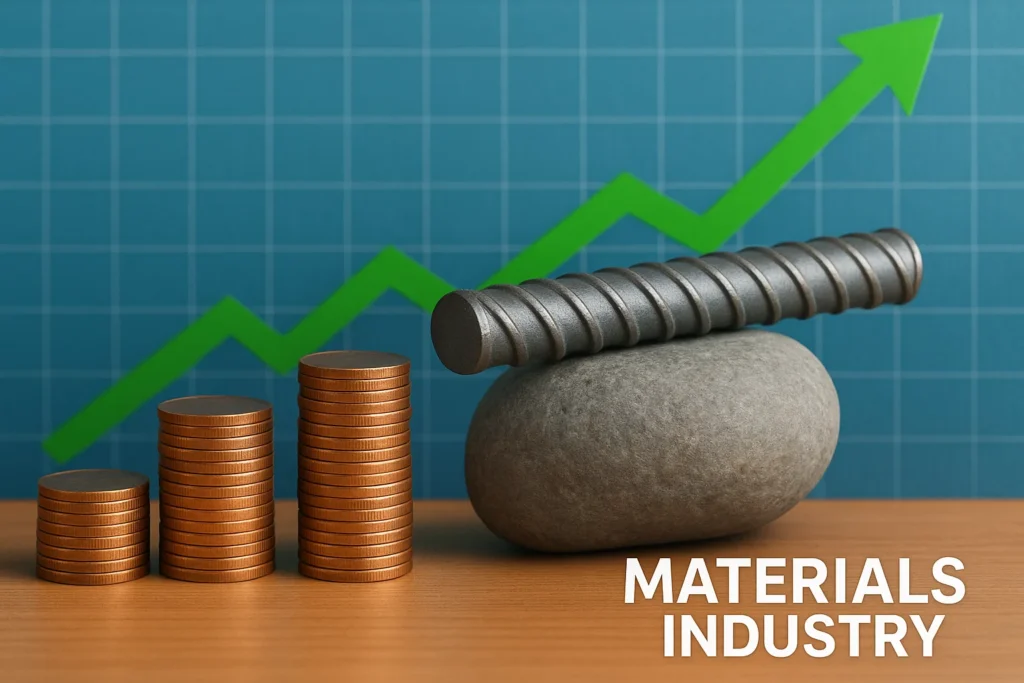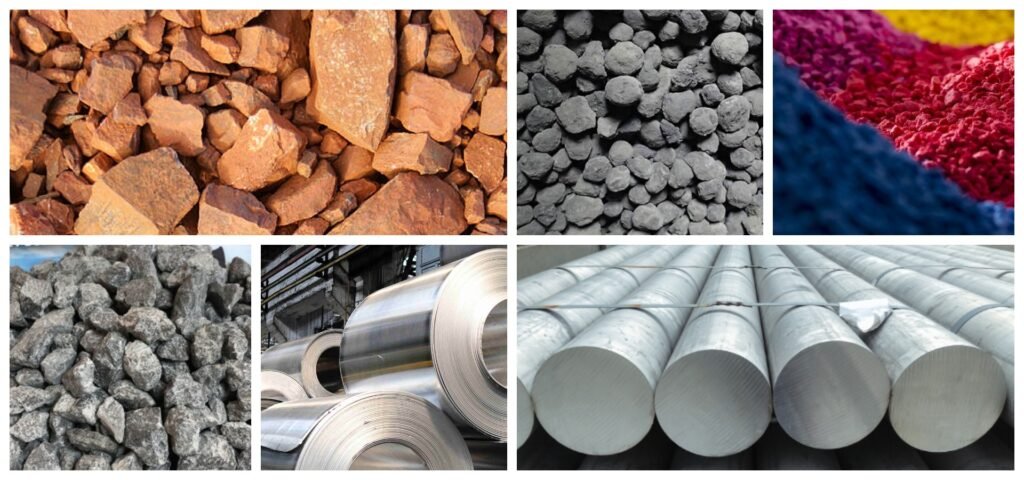Materials
- by:
- Nick H
Key Points
The materials sector provides essential raw inputs for every major industry, from construction to technology
Main segments include metals and mining, chemicals, construction materials, packaging, and paper products
Core drivers are global economic growth, commodity prices, technological innovation, and environmental regulation
For adsense add
Advertisement

affiliate add
For adsense add
Mail Sign Up
Get The Latest News & Stock Picks
Stay ahead of the market with expert news, actionable tips, and exclusive stock picks delivered straight to your inbox. Join a community of investors who value real insights and smarter strategies. Sign up now and get the edge you need to invest with confidence.
By submitting your email, you agree to receive updates and promotional content from our team. You can unsubscribe at any time. For more details, please review our Privacy Policy.
For adsense add
For adsense add
The materials sector forms the literal and figurative foundation of every industrialized society. From the steel that supports skyscrapers to the chemicals powering batteries and the paper in your hand, materials are present in nearly every product and process. This sector provides the raw ingredients for manufacturing, construction, infrastructure, technology, healthcare, and agriculture.

For investors, the materials sector offers unique opportunities for growth, income, and diversification. However, this is also a cyclical industry, closely tied to global economic trends, commodity prices, technological innovation, and environmental regulations. Understanding what drives the materials sector is key to making smart investment decisions.
What Is the Materials Sector?
The materials sector includes companies engaged in the discovery, development, processing, and distribution of raw materials. These firms extract, refine, and transform natural resources into products used across all industries. The sector’s main segments include metals and mining, chemicals, construction materials, containers and packaging, and paper and forest products.
Main Segments of the Materials Sector
1. Metals and Mining
Companies in this segment extract and process metals such as steel, aluminum, copper, gold, and lithium. Their performance depends on global demand, commodity prices, and mining technology. Key industries served include automotive, electronics, construction, and energy storage.
2. Chemicals
This diverse category covers specialty chemicals, industrial gases, fertilizers, agrochemicals, plastics, and basic chemicals. Chemical companies play a crucial role in agriculture, consumer products, pharmaceuticals, electronics, and advanced manufacturing.
3. Construction Materials
Firms in this segment supply products like cement, concrete, glass, aggregates, and bricks. Construction materials are vital for infrastructure development and real estate, making this sub-sector sensitive to building cycles and government spending.
4. Containers and Packaging
Packaging companies produce everything from metal cans and glass bottles to flexible plastics and cardboard boxes. Demand is driven by food, beverage, e-commerce, and consumer goods markets.
5. Paper and Forest Products
This segment includes timber, pulp, paper, and packaging producers. Products range from lumber for construction to specialty papers for publishing, hygiene, and packaging.
How Investors Access the Materials Sector
There are multiple ways for investors to gain exposure to materials:
Individual Stocks:
Major materials companies, from global mining giants to specialized chemical producers, are publicly traded.
Sector ETFs and Mutual Funds:
Funds focused on materials offer instant diversification across a range of industry segments and regions.
Commodity Investments:
Some investors use commodity ETFs or futures to target specific materials like gold, copper, or lithium.
What Drives the Materials Sector?
Several core forces shape growth and profitability in the materials sector:
1. Global Economic Growth
Materials demand rises and falls with the broader economy. Expansions drive up construction, manufacturing, and infrastructure spending, while recessions often reduce demand for raw materials.
2. Commodity Prices
The profitability of materials companies is directly tied to the prices of metals, minerals, chemicals, and other commodities. Prices fluctuate with global supply and demand, currency movements, geopolitical events, and speculation.
3. Technological Innovation
Advances in mining, refining, and materials science can cut costs, improve efficiency, and create new markets. For example, the electric vehicle revolution has increased demand for lithium, nickel, and cobalt.
4. Environmental and Regulatory Pressures
Materials companies face strict regulations on emissions, waste, land use, and resource extraction. Shifts toward sustainability and “green” materials are changing production methods and spurring innovation.
5. Supply Chain and Trade Dynamics
Materials are often traded globally, so tariffs, trade agreements, and shipping disruptions can impact availability and pricing. Political instability in resource-rich regions can also affect supply.
Leading Companies in the Materials Sector
The sector features a wide range of global leaders, including:
BHP Group (BHP): One of the world’s largest mining companies, with assets in iron ore, copper, and coal.
Linde plc (LIN): A top global supplier of industrial gases used in manufacturing, healthcare, and energy.
Dow Inc. (DOW): A diversified chemical giant with products spanning plastics, coatings, and specialty chemicals.
Vulcan Materials (VMC): The largest U.S. producer of construction aggregates and materials for infrastructure.

Risks and Challenges in the Materials Sector
Investing in materials brings unique challenges:
1. Cyclical Demand:
The sector is highly sensitive to business cycles, with revenues rising and falling alongside global growth.
2. Commodity Price Volatility:
Fluctuations in the prices of raw materials can rapidly alter company profitability.
3. Environmental Regulation:
Stricter rules on emissions, waste, and resource extraction increase compliance costs and can affect operations.
4. Supply Chain Disruptions:
Political instability, natural disasters, or logistical issues can hinder access to raw materials and distribution.
5. Innovation Pressure:
Companies that fail to invest in efficiency, sustainability, or new material technologies risk falling behind.
Materials Sector Outlook: Trends and Forecasts
Several powerful trends are shaping the future of the materials sector:
Sustainability and Green Materials:
There is a major push toward eco-friendly materials, recycling, and lower-emission processes. Demand for “green steel,” recycled plastics, and biodegradable packaging is growing rapidly.
Electric Vehicles and Renewable Energy:
The shift to electric vehicles and renewable energy sources is driving demand for specific metals such as lithium, nickel, cobalt, and copper.
Global Infrastructure Investment:
Governments around the world are investing in infrastructure, boosting demand for construction materials, metals, and specialty chemicals.
Digitalization and Advanced Materials:
Digital technologies, automation, and new material innovations are improving efficiency and opening up new markets.
Geopolitical and Trade Shifts:
Securing supply chains for critical minerals has become a priority for many countries, leading to new partnerships and investments.
How to Evaluate Materials Stocks
When analyzing materials companies, focus on:
Exposure to High-Growth Markets: Target companies positioned for rising demand in electric vehicles, renewable energy, or infrastructure.
Cost Structure and Scale: Low-cost producers with efficient operations are better positioned during commodity downturns.
Balance Sheet Strength: Look for healthy cash flow and manageable debt, especially in cyclical downturns.
Innovation and ESG Initiatives: Commitment to sustainable practices and new technologies is increasingly vital.
Geographic Diversification: Companies with global operations can reduce risk from local disruptions.
Conclusion: Materials’ Place in a Diversified Portfolio
The materials sector remains essential to the global economy and a core component of diversified investment strategies. It offers exposure to infrastructure growth, technological change, and sustainability trends, along with the opportunity for both growth and income. Investors who understand the sector’s drivers, leaders, and risks can benefit as materials continue to shape the world’s progress.
For adsense add












